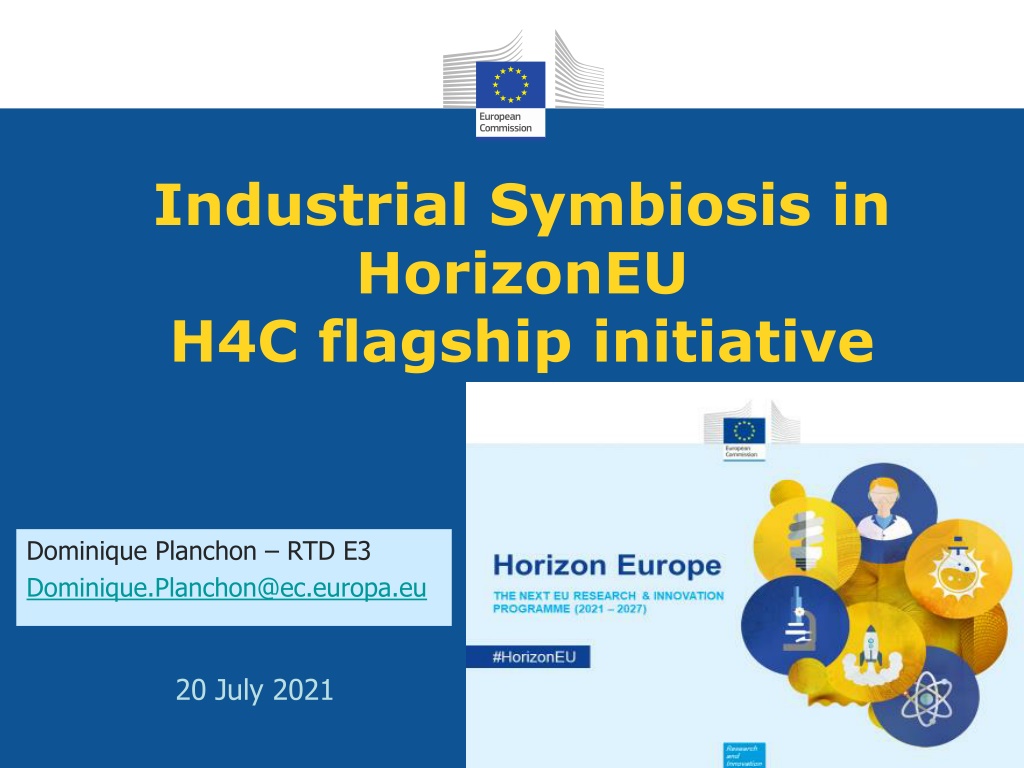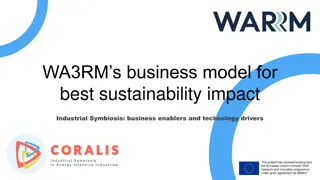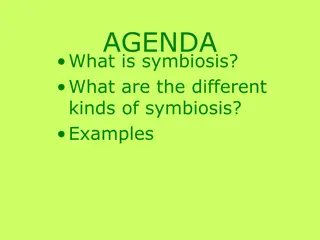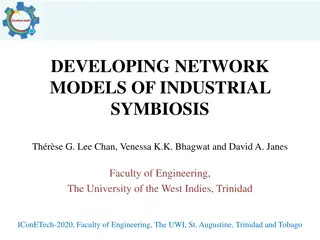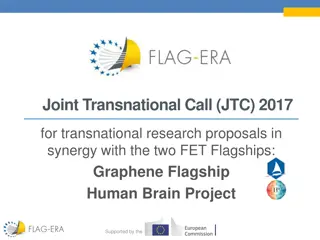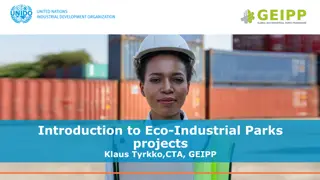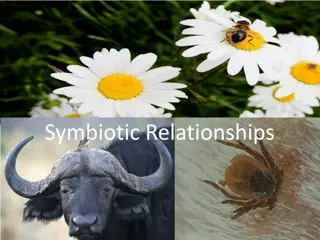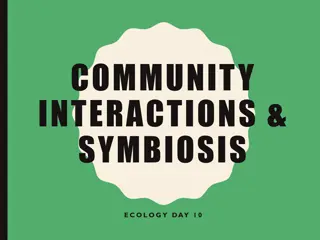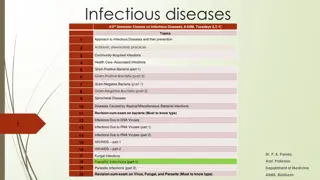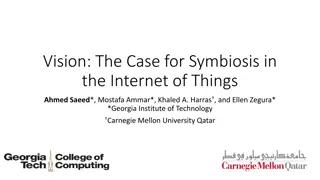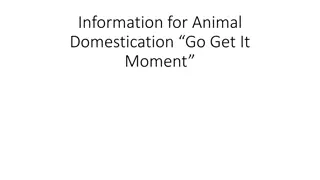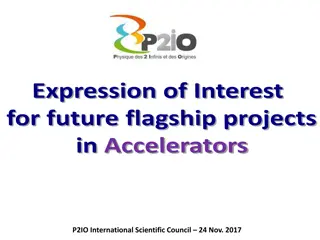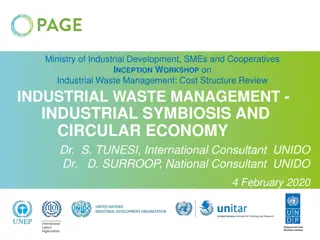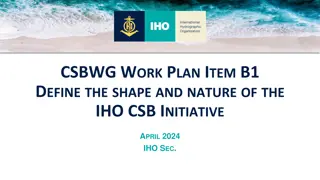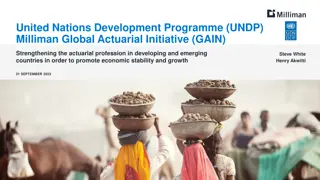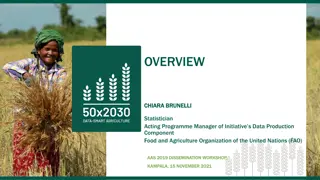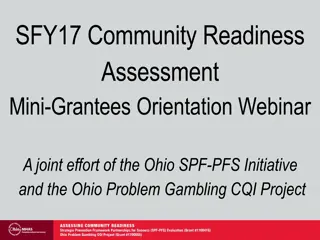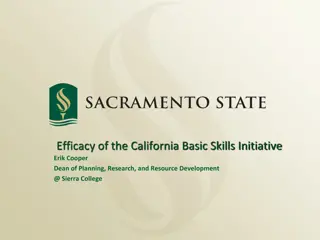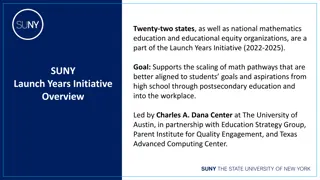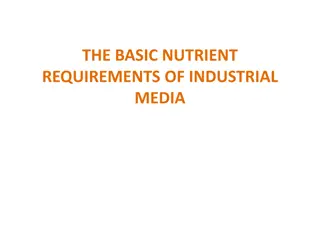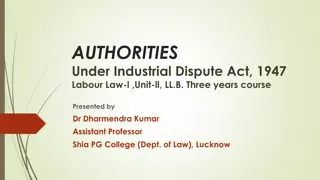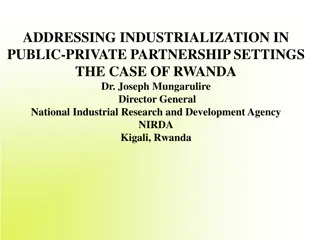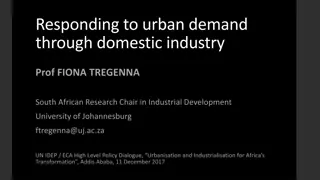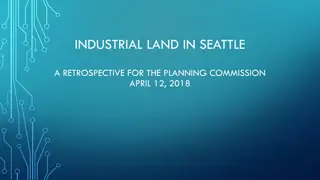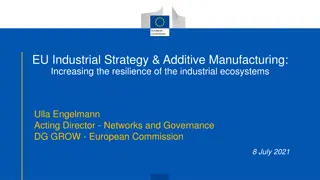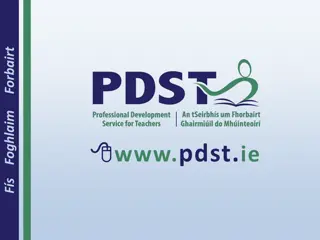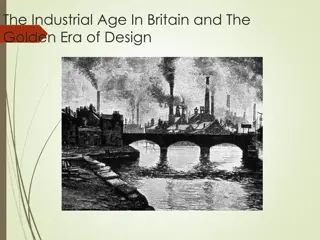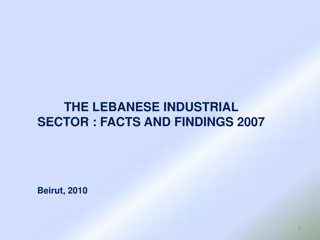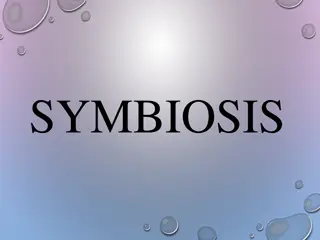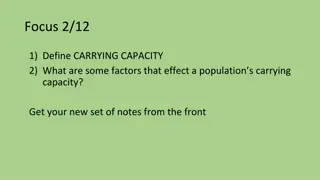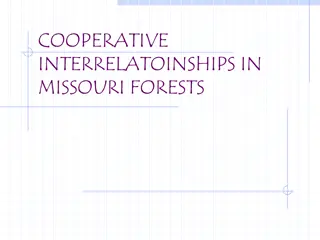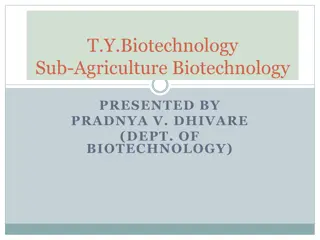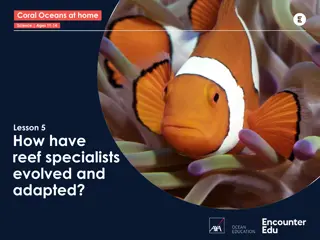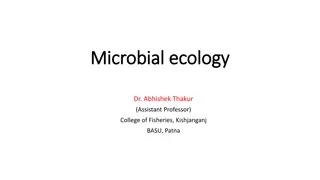Industrial Symbiosis in HorizonEU H4C Flagship Initiative
A new flagship initiative, Hubs for Circularity, aims to advance European industries towards the Green Deal's objectives by implementing industrial symbiosis and urban industrial symbiosis on a large scale. The H4Cs focus on achieving circularity and carbon neutrality in resource use while involving stakeholders like industry, SMEs, RTOs, local authorities, and civil society. Expert recommendations include using symbiosis readiness levels and supply-driven business models. The initiative provides opportunities for the deployment of industrial-urban symbiosis solutions at a regional scale.
Download Presentation

Please find below an Image/Link to download the presentation.
The content on the website is provided AS IS for your information and personal use only. It may not be sold, licensed, or shared on other websites without obtaining consent from the author. Download presentation by click this link. If you encounter any issues during the download, it is possible that the publisher has removed the file from their server.
E N D
Presentation Transcript
Industrial Symbiosis in HorizonEU H4C flagship initiative Dominique Planchon RTD E3 Dominique.Planchon@ec.europa.eu 20 July 2021 1
A new flagship initiative Hubs for Circularity Concept, opportunities & challenges for successful implementation As Part of Processes for Planet (P4P) Partnership roadmap, the Hubs for Circularity (H4C) will be a key instruments to advance the research and innovation agenda of European industries towards the Green Deal s objectives. These first-of-a-kind, lighthouse demonstrator plants of (near) commercial size implementing industrial symbiosis and/or urban industrial symbiosis. The aim is to collectively achieve and demonstrate at scale, a leap towards circularity and carbon neutrality in the use of resources (feedstock, energy and water) in a profitable way. H4Cs have a strong technological focus and industrial dimension, but their implementation leverages elements well beyond research and innovation. Specific implementation (including funding) strategies will have to be co -designed, ensuring the participation of all stakeholders; industry, Small and medium-sized enterprises (SMEs), research and technology organizations (RTOs), local authorities, educational institutions and civil society.
H4C - Expert Recommendations Use of symbiosis readiness levels SRLs Supply-driven business model evolve in a more forward-thinking demand-based by-design approach. Facilitation (public or private): essential to foster the development of Industrial Symbiosis. Start within an existing group of companies in local proximity, be it an industrial park or a more loosely arranged cluster. Industrial Symbiosis approach can be applied broadly to many different industrial sectors. *Study and portfolio review of the projects on industrial symbiosis in DG Research and Innovation https://op.europa.eu/en/publication-detail/-/publication/f26dfd11-6288-11ea-b735-01aa75ed71a1
Call - TWIN GREEN AND DIGITAL TRANSITION 2021 Hubs for circularity, a stepping stone towards climate neutrality and circularity in industry HORIZON-CL4-2021-TWIN-TRANSITION-01-14: Deploying industrial-urban symbiosis solutions for the utilization of energy, water, industrial waste and by-products at regional scale (RIA) HORIZON-CL4-2021-TWIN-TRANSITION-01-16: Hubs for Circularity European Community of Practice (ECoP) platform (CSA)
HORIZON-CL4-2021-TWIN-TRANSITION-01-14: Deploying industrial-urban symbiosis solutions for the utilization of energy, water, industrial waste and by-products at regional scale (Processes4Planet Partnership) (RIA) Expected Outcomes : Deploy real scale exemplary pilot solutions of the Industrial-Urban Symbiosis (I-US) concept, making the flows of energy, waste and water circular, achieving near-zero GHG emissions and near-zero water discharge; Reduce by 50 % (in weight or volume) industrial waste generation and reduce significantly the associated GHG emissions, by re-using and transforming waste, by-products and side-streams into new resources or raw materials; Plan a list of actions to overcome non-technological barriers for exploitation of cross-company symbiosis (i.e. waste regulations, standardisation, confidentiality and compliance, ownership, fair sharing of benefits, acceptance of the concept); Set up facilitation services for helping implementation of symbiotic processes directed to local authorities, and relevant businesses, private/industry actors, especially SMEs; Develop best practices for knowledge-sharing on technological and non-technological aspects (i.e. job profile optimisation) in close collaboration with the European Community of Practice (ECoP) CSA and other relevant bodies, dissemination the major innovation outcomes to support the implementation of I-US; Explore and demonstrate replication potential in other regions (i.e. by setting up a network amongst waste associations to optimise flow of secondary raw materials); Implement actions to facilitate relations and to involve the local community actors (authorities, associations, civil society, relevant businesses, especially SMEs, educational organisations, etc.), e.g. exchanging knowledge and human capital with the educational establishments and developing flexible learning resources. Implement a social innovation spin-off action involving one of the local community actors. Relevant indicators and metrics, with baseline values, should be stated clearly in the proposal. EU contribution per project: EUR 8.00 12.00 million Indicative budget: EUR 28.00 million Type of Action: Research and Innovation Actions - TRL: Start at 4 and achieve 6
HORIZON-CL4-2021-TWIN-TRANSITION-01-16: Hubs for Circularity European Community of Practice (ECoP) platform (Processes4Planet Partnership) (CSA) Expected Outcomes : Establish a European Community of Practice (ECoP) as an effective and sustainable forum/platform connecting hubs for circularity (H4C) and all actors willing to invest in industrial urban-symbiosis (I-US), towards building new circular value chains; Provide up-to-date support to the H4C by collecting and evaluating knowledge, tools, models and solutions and making them accessible to the community, preparing training material dedicated to circular practitioners that can drive the H4C roll out across Europe; Define a set of methodologies and kits of specific KPIs (e.g. a kit for any single industrial sector) to enable the progress quantification of circularity and symbiosis with particular attention to the definition of gaps to be closed in order to reach the expected impact. Analyse collaboration models, non-technological barriers, tools, technologies and existing solutions for I-US and circularity, especially those from previously funded projects; Provide a state-of-play analysis of regions/areas best suited for the first implementation of advanced H4C in Europe, coupled with a detailed study of the strength and weaknesses of the regions/areas selected, including a symbiosis maturity level (Symbiosis Readiness Level, SRL) and a number of specific scenarios for the technology and process implementation; Establish a roadmap on how to achieve an effective implementation of a certain number of first-of-a-kind pilots of advanced H4C by 2026, supported by a solid blended funding strategy, targeting the accomplishment of 2050 Green Deal Goals; Spread the H4C concept to all regions of Europe, support the H4C cooperation network and promote the transfer of the circular models across sectors and borders;
HORIZON-CL4-2021-TWIN-TRANSITION-01-16: Hubs for Circularity European Community of Practice (ECoP) platform (Processes4Planet Partnership) (CSA) Expected Outcomes (cont) : Stimulate public and private investments in circular economy projects; Set up an effective collaboration with stakeholders represented in the P4Planet partnership, including non- governmental associations, and provide a solid plan for the continuation and self-financing of ECoP after the completion of the project; Drive and coordinate business-to-territory relationships in the area in which the H4C, or neighbouring H4C, are located (i.e. with authorities, SMEs, associations, educational organisations, civil society, etc.). EU contribution per project: around EUR 2.00 million Indicative budget: EUR 2.00 million Type of Action: Coordination and Support Actions TRL: -
Work Programme topic 1. What are you looking for? Green industrial transition through implementation of IS, IUS and circularity in large scale demonstrators. Industrial symbiosis is the process by which wastes or by products of an industry or industrial process become the raw materials for another. ... This process serves to reduce the environmental footprint of the industries involved. innovative approach that brings together companies from all business sectors with the aim of improving cross industry resource efficiency through the commercial trading of materials, energy and water and sharing assets, logistics and expertise. Clustering industries around common green targets.
Work Programme topic 2. What do you NOT want? 1 single circular loop targeting one single value chain; Small scale demonstrators; Development addressing only waste utilisation of a single process;
Clarification : What is and what is not a social innovation spin-off action It s not a repetition of the expected outcome of involving the local community (authorities, SMEs, education, etc.) also covered in these topics and inherent to a H4C. It s something special, an added-value we are bringing to the topic for the sake of social innovation. It s just 1 concrete action, not a collection of them, focused on 1 local community actor because if the target is too broad, it loses the impact (and divert the funding). It is not expected to be duly described in the proposal. Because social needs, the ones for which we can really bring an innovative solution thanks to a H4C, arise on the field. At the stage of proposal, consortia might have spotted something or even have some social needs identified, but definitely not a duly plan of a spin-off action when the focus is on starting a H4C of industrial symbiosis and get the local community involved. An innovative idea comes with the time, while collaborating with the local community and observing what is going on in a territory, only then realising which local group can really benefit from some direct or indirect action from a H4C. It s not about collaborating with local educational establishments introducing new material in the curricula.. It s about creating an action with own life ,something that can be marketed by itself. It may continue after the end of the funding or not and can or cannot end up as a commercial activity. 11
Work Programme topic topic evolution 3. Is this new or has it been called before? No previous topics addressing IUS, zero-landfill and water utilization in a systemic and holistic way; See Klaus Somer report for an overview of previous work https://op.europa.eu/fr/publication-detail/-/publication/f26dfd11- 6288-11ea-b735-01aa75ed71a1
Work Programme topic topic evolution 4. Current project portfolio See Klaus Somer report for an overview of previous work https://op.europa.eu/fr/publication-detail/- /publication/f26dfd11-6288-11ea-b735-01aa75ed71a1
Work Programme topic Key actors 5. Who are the types of main stakeholders that are addressed? Large and medium companies, SMEs Public regional and local authorities Research entities, higher educational institutions Civil society 6. Is there a key group of actors (eg. Partnership or other) driving this? Processes4Planet partnership
Work Programme topic 7. Are there any additional / background documents? P4P roadmap Klaus Somer report Circular economy action plan Zeropollution action plan Industrial strategy Chemical strategy Green deal
Future Outlook 8. Do you have information about future trends, emerging initiatives, roadmaps, type of stakeholders in this area? Some examples: Kalundborg symbiosis Smart Delta Resources City of Lahti
